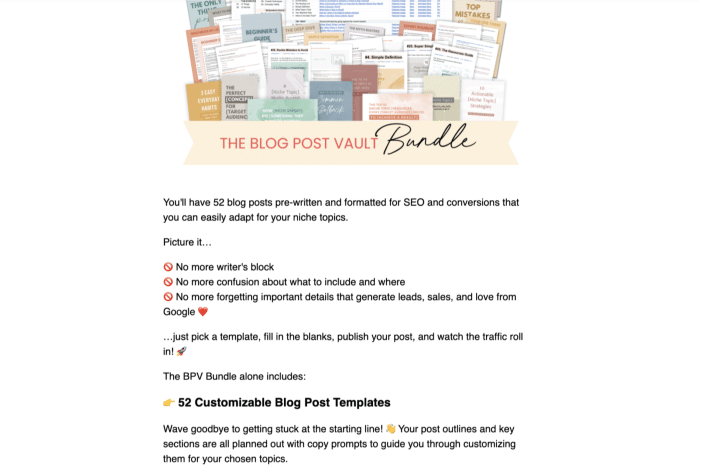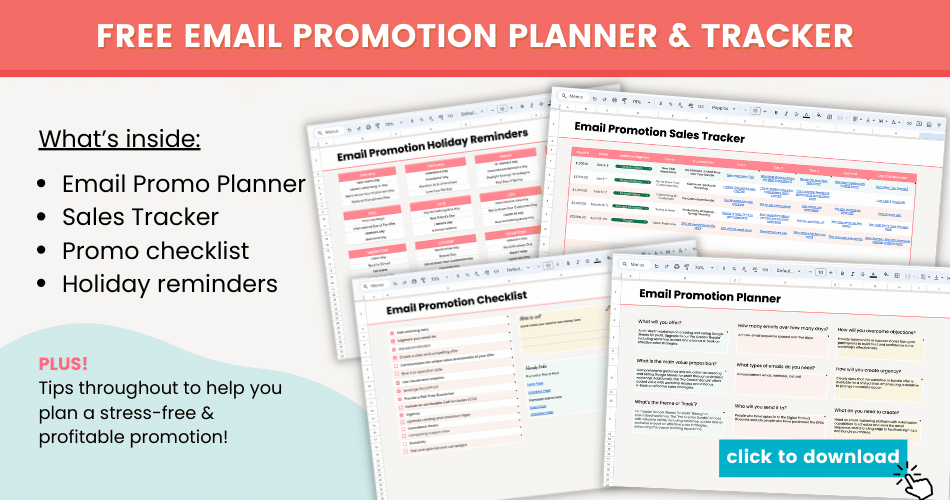So you’re ready to run your first email flash sale, congrats! 🎉 It’s our favorite way to boost sales, convert email subscribers into customers, and increase our customer lifetime value.
But if you’re anything like us when we were first starting out, the thought of selling to your audience might have you feeling a little nervous – gulp, am I right? 😬
It’s totally normal to feel that way, but with a little bit of preparation and planning, you can be a flash sale rock star in no time.
To help you do that, we’ve put together a list of 8 things you should do before running your first email promotion or flash sale to make sure it runs smoothly and so you’re not stressing anything last minute.
But before we get too far, be sure to grab our FREE Email Promotion Planner so you can take what you learn here on-the-go. It also includes a Promo Tracker, Checklist, and list of Holidays & Occasions to inspire your email flash sale and promotional campaigns.

Ready? Let’s get started!
#1. Decide What You’ll Offer
Every successful promotion needs a compelling offer, and it isn’t just the product or service you’re selling – it’s the timeframe you’re making it available, the price, bonuses, add-ons, options, order bump, refund policy – all of it.
It may seem like a no-brainer, but you’d be surprised how many people don’t take the time to really think through their offer or how they’re going to communicate it.
But get this right and everything else is just icing on the cake. 🎂
Whether you’ll be offering a discount, a limited time bundle, or exclusive access to a product or service, you want to ensure it’s clearly understood by your audience who it’s for and why they need it.
So take some time to consider the following questions:
- Will you offer multiple items or just one product or service?
- Do you need to create a new package or bundle?
- Will you add a bonus to make your offer more enticing?
- Can you throw in an incentive such as a free gift with purchase?
- Will you provide free shipping?
Start with the “what it is” and then…
#2. Get Clear About Your Offer’s Value Proposition
Your email copy should explain the transformation your customers can expect when they purchase and the ways your product or service differs from other options your subscribers may be considering. That means clearly articulating the features, benefits, and what results they can expect in your email copy.
⚠️ Important: make it easy to read and concise.
Questions to consider when communicating your offer’s value are:
- What problem does it solve?
- Who is it for?
- What benefits or results can they expect?
- How is it different from other solutions out there?
Be confident and let your audience know that your offer is the best choice and the time is now for them to buy.
Here’s an excerpt from our most recent promotions. Notice that we’re not just explaining what’s included, we’re telling a story of what life will be like after they make a purchase…

In this promotion, what we’re selling is a system of blog post templates, but what we’re really selling is the elimination of stress, confusion, and wasted time when it comes to blogging.
So think about the “before” and “after” emotional state of your audience and paint that picture for them!
#3. Decide on the Theme or “Hook” of Your Email Promotion
Just showing up out-of-the-blue and saying “Hey, buy my stuff” is awkward to say the least. So having a captivating theme or hook will give you the “excuse” you need to show up in your audience’s inbox to pitch them your offer.
This is why holiday promotions are such a big thing. There’s nothing in particular about Memorial Day that makes it a great time to buy a waterbed, it’s just that the holiday provides the hook and marketers take advantage of that.
Examples of email promotion themes include:
- Holidays & Observances – e.g. Valentine’s Day, 4th of July, Black Friday
- Special Occasions (“make your own holiday”) – e.g. celebrating a business milestone, # of customers, news story
- New product/service launch
- Product/service update
#4. Determine the Number of Emails Needed and the Promotion Duration
Plan how many emails you’ll send (3? 5? 7?) and how long your flash sale promotion will run (1 day? 3? 5?). There are no set rules here and it can take a bit of experimentation to understand what works best for your audience. But to give you an idea…
We generally limit email promotions and flash sales to a span of 4 days so we don’t fatigue our audience. For our audience at least, we’ve found that running promotions longer than that doesn’t yield better overall sales results.
Of course every business is different, but when you’re just starting out, 4 days or less is a good number because it allows you to create a sense of urgency and excitement but it isn’t so short that people miss it.
If we plan to do a 4-day promotion, the # of emails we send will be 5.
Here’s a typical formula we follow:
Day 1 (1 email): Announce the promotion
Day 2 & 3 (1-2 emails): Promotion reminders using different angles (e.g. address pain points, answer FAQs, provide case studies and social proof, etc.)
Day 4 (2 emails): Final email + “last call” reminder a few hours before the promotion ends
We think of it like a sandwich (which we go into in more detail in our soup-to-nuts Beginner’s Guide to Email Promotions) — every promotion has an opening (announcement email) and a closing (reminder that the promotion is ending) and in between there’s a bit of flexility in the types of emails you’ll send.
For the “middle of the sandwich,” think about speaking to different segments of your audience. What are the different problems, questions, and objections they may have? Each email can have a different subject line and hook so you increase your chances of your emails getting opened.

Of course there’s lots of room for experimentation within that framework and you’ll learn from every promotion you run what works best for your business, but hopefully this gives you a good place to start!
#5. Segment Your Audience
Will you email your entire list or only certain segments? Tailoring your emails to specific segments ensures better engagement and higher conversion rates.
Too many promotional emails sent to the wrong people will only cause them to unsubscribe, and that would be a shame because the next promotion might be the perfect fit!
Of course you’ll want to exclude the people who’ve already purchased and may want to exclude those who’ve opted into a freebie that isn’t relevant to your offer.
#6. Don’t Forget to Address Objections
Your audience will have objections and doubts about making a purchase and you should address them in your email copy.
Even if you’ve done a bang-up job communicating your value proposition, you can still fail to convert people with lingering doubts and questions.
Figuring out what those doubts might be can be a challenge, but it’s made easier these days with tools like ChatGTP. While I’m not a huge fan of having AI generate the sales copy itself, it’s a fabulous tool for getting audience intel. You can provide ChatGPT with all the information about your offer and target customer and then ask it to generate a list of objections, questions, and false beliefs they may have about your product.
Here are some common objections to get you started:
- Price concerns: it’s too expensive / can I find it cheaper?
- Quality doubts: will it meet my expectations? is it good enough?
- Trust and credibility: can I trust this company?
- Need assessment: Do I really need this? Can I manage without it or find an alternative solution?
- Return policy and guarantees: What if I’m not satisfied with the product/service? Is there a hassle-free return or exchange policy?
- Fear of making a wrong choice: What if I regret this purchase later?
- Delivery time and logistics: How long will it take for the product/service to be delivered?
- Lack of information: Is there enough information available about the product/service? Are there any hidden terms or conditions that I should be aware of?
There are lots ways to handle objections in your copy, such as:
- Offering a satisfaction guarantee or a hassle-free return policy to reduce the perceived risk.
- Showcasing positive reviews, testimonials, or social media mentions related to the product or service on offer. Social proof builds trust and confidence in their purchasing decision.
- Answering “FAQs”
Pro-tip: If you have testimonials, a very effective conversion copywriting hack is to answer a frequently asked question and then show a testimonial that backs up your claim. To give you a very stripped down example of what this looks like:
Question: “Will this save me time?”
Your Claim: “Yes, it will save you on average, 20 hours per month!”
Then, immediately follow with a relevant testimonial as proof: :
“This product saves me 20 hours per month! – Customer Name”
Pretty cool, right? 😉
#7. Decide How You’ll Create Urgency
The biggest mistake people make with their email promotions is not creating urgency. Limited-time offers or exclusive deals encourage recipients to act quickly but you have to put a time limit on your offer or people won’t take action.
For example, you could offer a discount or free shipping for a limited number of orders, or offer a product or bundle of products for a limited time only.
Make sure to make the deadline clear and emphasize it in your email. Use phrases like “Act now” and “Don’t miss out” to emphasize the importance of taking action quickly.
You can also use countdown timers on your sales pages, checkout pages, and in your emails themselves which is possible with tools Deadline Funnel.
#8. Prepare Necessary Assets & Tech (Plan Ahead!)
Finally, consider in advance what assets you’ll need to support your promotion. This might include creating a landing page, designing graphics, or preparing a special bundle or bonus. Ensure everything is ready to go when you hit ‘send’.
To help you plan your email promotions so they go off without a hitch, be sure to grab our FREE email promotion planner and tracker below.
You’ll be reminded of all the things you need to think about, include, and prepare for and when your promotion is done, you’ll be able to track and analyze your results so you can keep learning about what works best for you!

Note from Taughnee: In the following blog post, I used the “What to do before” template from the Blog Post Vault. The final post is 100% original content using my own voice, unique perspectives, and personal insights. But, using BPV helped me write, edit, and format over 1,500 words for this post in less than an hour, whooo hooo!

